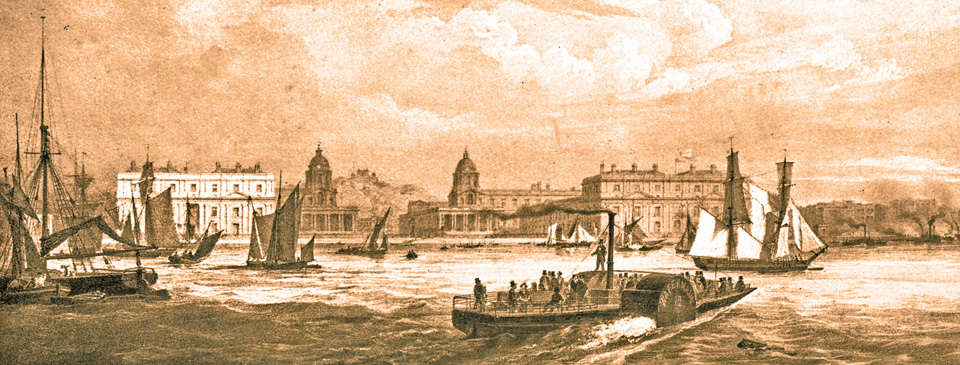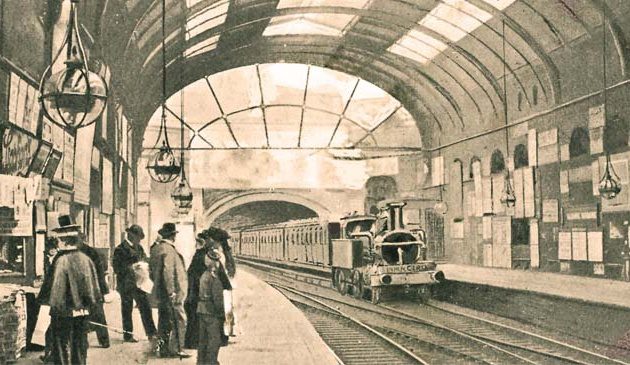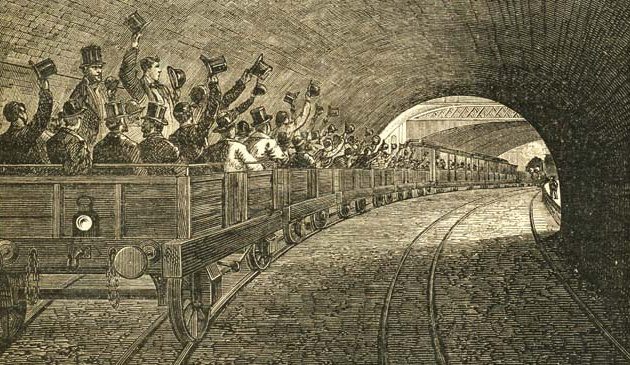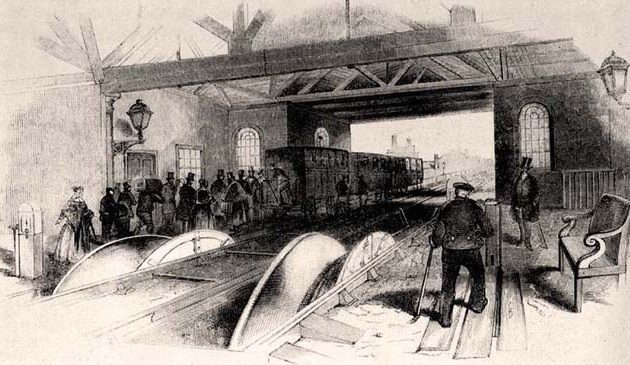Victorian passenger steamboats on the Thames

A vessel of the Waterman Steamboat Company in the 1840s. Other steamboats can be seen in the distance on the right of the picture. It appears not to have any below-deck cabins and was therefore probably a ‘short-ferry’, plying between Greenwich and London rather than a long-ferry or designed for longer day-trips. The Waterman’s pier at Greenwich was constructed to take a million passengers a year.
The speed limit was 4 mph for vessels in the Pool of London but steamboats regularly travelled at twice that speed, with frequent collisions between them. Cut-throat competition between steamboat companies meant that every minute counted to travel from one destination to the next. Vessels stopped only briefly at piers for passengers to embark and disembark, usually only a minute. They often pulled away at full speed and accidents occurred. In 1843 thirteen children were thrown into the river. Three drowned immediately and it is possible some of the others died later from swallowing polluted river-water.
The speed at which steamboats travelled, as well as loss of income, created regular conflict with Thames watermen, whose families had been ferrying travellers at a more leisurely pace for generations. In 1844 a steamboat ran down a waterman’s wherry and killed him. The master was found guilty of manslaughter but received a sentence of only four months in jail. Watermen were not above damaging piers.
The New Cricket, powered by an early example of a dual expansion engine and operated by Penny Steamboats, had only been in service a short time when its engine exploded at Adelphi Pier near Hungerford Bridge in August 1847. One hundred and fifteen passengers were on board at the time. Seventeen were killed instantly and 60 severely injured. Many were thrown into the river and rescued by watermen. The New Cricket’s engineer was convicted of manslaughter for tying down the safety valve, no doubt to increase the boat’s speed. The ensuing investigation found that, unlike buses and cabs, steamboats were largely unlicensed and that the fierce competition had affected safety standards. The rival London & Westminster Company took advantage of the Penny Steamboat’s loss and quickly put their London Pride into service on the route.
The Princess Alice paddle-steamer was built in 1865 for service on the Clyde with a capacity for 400 passengers. With a relatively thin iron hull, she was not built for sea service and, found to be unsuitable for her original purpose, was sold to the London Steamboat Company. They added saloons above deck, had her certified for 899 passengers, and operated her on excursions. In September 1878 the Princess Alice was returning from a day excursion to Sheerness, picking up additional passengers at Rosherville pleasure gardens. There were then about 800 passengers on board, together with 23 crew. Reaching Beckton gas works off Tiptree Point at 7.40pm she collided with the much larger Bywell Castle, an empty 890 ton steam collier proceeding downriver at the start of its journey from Millwall Dry Dock to Newcastle. The impact was so severe that the Princess Alice was cut in two and sank in less than four minutes. Forty people managed to survive in three lifeboats from the Princess Alice but over 700 lives were lost, including two sons of the company’s General Manager. Only 544 bodies were recovered and many never found. Within six years the company had gone bankrupt.
The zenith of steamboat services was reached in around 1848. In that year there were twenty-eight London to Greenwich and Woolwich short-ferries in operation and three from Blackwall, twenty-three daily long-ferry departures from London to Gravesend, and ten vessels serving Herne Bay, Southend and Margate.
Steamboat services to Estuary resorts came under competitive pressure from railways from the 1850s. The journey by boat from London to Ramsgate took six and a half hours weather-permitting, compared with only four and a half hours by train in most weathers. The river services responded by lowering their fares and day-trippers continued to take the slower steamboat services, perhaps for the sheer pleasure of being on the water. However, the steamboat companies began to sell off their vessels and reduce the number of services.
In about 1875 the London Steamboat Company, based at Bennet’s Hill in the City, acquired the vessels and piers of the Iron, Citizen, London & Westminster, Waterman’s, and Woolwich Steam Packet companies. Their fleet then consisted of around sixty vessels, of which about half operated down-river and the other half up-river from the City as far as Kew. For several years they ran a steamboat every ten minutes during the daytime and evening between London Bridge and Chelsea. Their boats Queen of the Orwell and Queen of the Thames ran daily around the coast between London and Ipswich, calling at Clacton, Walton-on-the-Naze and Harwich. The LSC fares were very moderate but doubled on Sundays and Bank Holidays, indicating that travel by steamboat was by then primarily a pleasure excursion.
During the course of the 19th century larger steamboats came into service. The London, Woolwich & Clacton-on-Sea Steamboat Company commenced operating from 1890. They brought into service various palatial vessels in their Belle fleet, running as far as Yarmouth and Ramsgate. The independently-owned paddle-steamer La Marguerite, 330 feet long and 40 feet wide, was built in 1894. It was licensed to carry 3,000 passengers from Tilbury (where excursionists from London arrived there by train) to Margate or 2,000 passengers across the Channel to Boulogne. In the early 1890s the London Steamboat Company transformed into the Victoria Steamboat Company, with a less extensive service calling at fewer piers. The company had two vessels of note: the Koh-i-nor on the London-Clacton-Margate service, and the Royal Sovereign from London calling at Margate, Ramsgate, Deal and Dover.
In 1905 the London County Council experimented with a fleet of 30 small paddle-steamers on the Thames. However, the days of steamboat travel along the river, affected by tides and weather, had by then passed, with commuting by bus and train faster and more reliable. After one season the fleet was sold for scrap at enormous loss.
Sources include: G.A. Sekon ‘Locomotion in Victorian London’; Jerry White ‘London in the 19th Century’; Felix Barker & Peter Jackson ‘Pleasures of London’; Mike Paterson, London Historians blog; Liza Picard ‘Victorian London’; John Richardson ‘The Annals of London’.
< Back to London during the mid-19th Century


